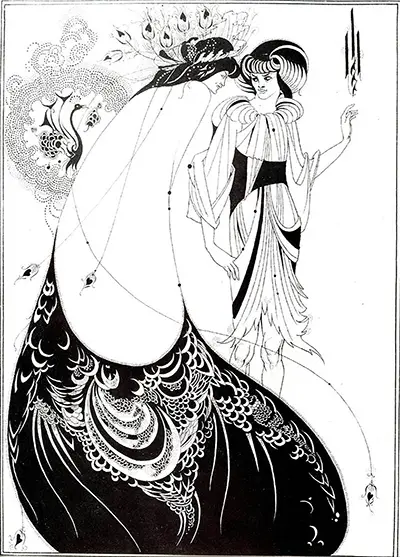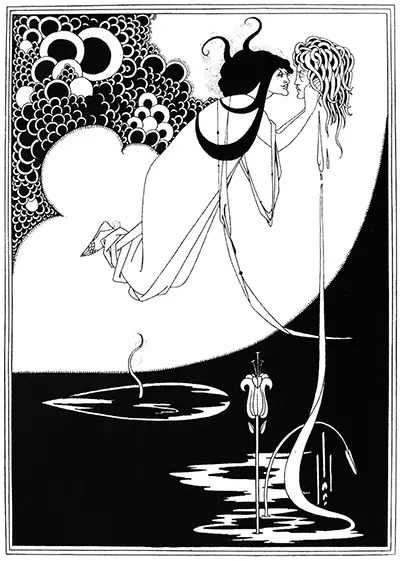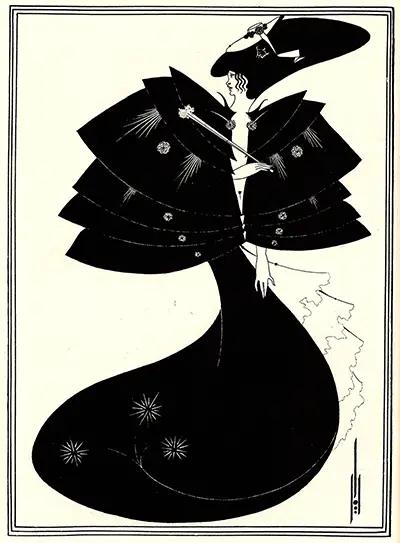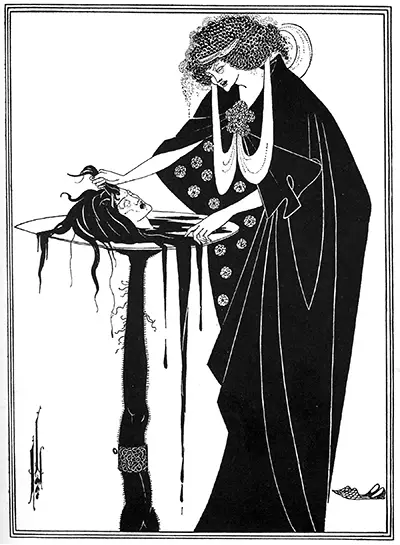The Peacock Skirt is an illustration by Aubrey Beardsley which was completed in 1893. It was part of a series of drawings that he completed for a publication of Salome which followed a year later.
Introduction to the Salome Series
Many different prints have been made from the original design, but Beardsley's work was completed in pen and ink. He relied on the woodblock print method to translate the design into the later publication and influences on this process came from Japanese art, with which the artist was well acquainted. Salome itself was a play written by Oscar Wilde which had originally been created in French, with a new English publication choosing Beardsley for its illustrations. Oscar Wilde came across a drawing produced by Beardsley which celebrated Salome's release in Paris and was excited by what he saw. He wrote directly to the artist and invited him to work on the English version whilst others translated it at the same time. Wilde's relationship with Beardsley would have it ups and downs, and the illustrator would sometimes be on the end of Wilde's cutting tongue, but at other times that was a great respect between the two.
Inspiration for The Peacock Skirt
The inspiration for this drawing, as well as Beardsley's more general use of peacocks which followed into other artworks, was from the career of James McNeill Whistler. The American painter was a star of the Aesthetic Movement and he decorated a dining room in London for British shipping magnate Frederick Richards Leyland. The room from then on was to become known as The Peacock Room, because of the content used on various artworks which adorned this incredible display. The entire set of works was later relocated to the US, but Beardsley was able to see it in person before it was moved. Whistler also worked alongside Thomas Jeckyll on this project and The Peacock Room has become known as a highly influential moment in the history of interior design. Beardsley himself was mightly impressed by what was achieved during the period of 1876–77, visiting it around two decades later and considering it to still be very contemporary in style. He openly spoke about his admiration for this project as well as how it had specifically inspired The Peacock Skirt, as well as other touches to his illustrative work.
Description of the Illustration
Salome appears as the left of two figures, with her image most memorable for the stunning detail added to her swirling dress. Beardsley adds patterns inspired by peacock feathers across the garment and continued this idea into other drawings as well. The robe in The Peacock Skirt is elongated beyond reality, bringing a contemporary feel to the overall image. The body of Salome is twisted and stretched, with her figure filling most of the vertical length of this drawing. Her head, by contrast, is relatively small, and also holds an elaborate type of headwear which brings further aesthetic interest to the piece. You will also discover the same peacock feather pattern on that as well, providing a consistency to the detail across this artwork. Salome is angled slightly to the side and with her back to us, leaving us viewing her from the side which was an unusual choice for any style of figurative art. Salome appears in conversation with her companion whose indentity has never been confirmed, though is rumoured to be one of the characters from the play known simply as "Young Syrian".
Techniques used in the Printing Process
The Bodley Head in London would eventually publish Beardsley's work within the new Salome book. John Lane worked at The Bodley Head and over time he would build a strong relationship with Beardsley, even though they would regularly argue about the suitability of some of the artist's designs. The wood block process was overseen by Carl Hentschel, who actually carved the images himself and later appended his own initials into the prints. Later versions made use of alternative printing techniques and the industry was moving fast at this point, regularly finding new ways of producing more precise and varied prints. Photography also started to play a role within the process as well, bringing yet more possibilities to professional publishers. John Lane chose to re-visit this project in the early 20th century and released a portfolio of Beardsley's designs in their original pre-approved state, without any of the accompanying texts from Wilde's play. He had clearly been struck by the beauty of the illustrator's earlier contribution, and brought in some of the designs that were rejected for the previous iteration.







